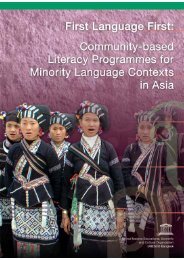Part II.pdf - MTB-MLE Network
Part II.pdf - MTB-MLE Network
Part II.pdf - MTB-MLE Network
You also want an ePaper? Increase the reach of your titles
YUMPU automatically turns print PDFs into web optimized ePapers that Google loves.
Policy and expansion of the project: There<br />
are over 200 languages in the northeast of<br />
India. Most of these languages do not have<br />
written scripts of their own. Mother-tongue<br />
education will become feasible only when<br />
there are learning materials in these languages.<br />
SRC Assam started its literacy campaign in<br />
ethnic languages with the preparation of<br />
materials in Bodo and Rabha. The next<br />
project to be taken is Tiwa. Our work in<br />
Rabha has caught the attention of influential<br />
people and educators in many language<br />
groups, like Deori and Karbi, from Assam and<br />
some languages of Arunachal Pradesh. These<br />
groups have approached us to publish books in their native languages. SRC, for instance, successfully<br />
brought out a primer in the Galo language last year.<br />
Philippines<br />
Action Research on the Development of an Indigenous Peoples<br />
Education for the Magbikin Tribe in Morong, Bataan, The<br />
Philippines<br />
Dr. Milagros C. Valles 1<br />
1. Introduction<br />
For years, the Philippines has been noted for its high literacy rate. Based on the l994 FLEMMS,<br />
the Simple and Functional Literacy Rates of the Philippines are 93.9% and 83.8%, respectively.<br />
Although the country enjoys these national literacy rates, pockets of illiteracy in the rural areas,<br />
particularly in the indigenous peoples’ (IP) communities still remain. It is noted that the regions<br />
where illiteracy rates are high are also the areas characterized by the following:<br />
• Population growth is high, thus negating gains in economic growth<br />
• A significant rise in the number of out-of-school population and young adults<br />
• More than half of the population is below the poverty threshold<br />
• A high rate of unemployment and underemployment<br />
• Average annual family income is below the national average and inequity in income<br />
distribution is marked<br />
• Incidence of malnutrition and both maternal and infant death is generally high<br />
1<br />
Bureau of Non-Formal Education, Department of Education, Pasig City, the Philippines<br />
181
















